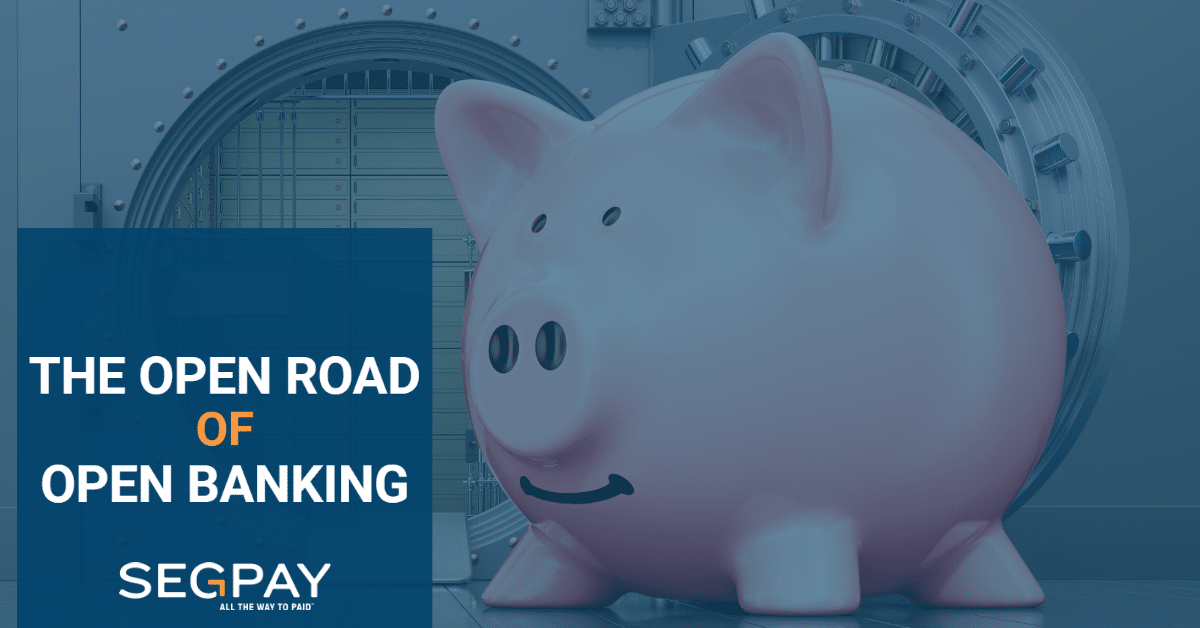- 3 minute read
Banking in the EU changed forever in 2020, when we had to gain compliance for the EU’s 2nd Payment Service Directive (PSD2). PSD2 focused on consumer security and transparency. A large part of the compliance effort was PSD2’s Secure Customer Authentication (SCA) requirement that mandated most EU consumer-initiated transactions be processed through an EU acquirer and be double authenticated. That same PSD2 mandate opened up the banking network and put business and consumers in the driver seat when it came to moving money by removing the friction from the banking network. This month we take a deep dive into what open banking is and how it impacts us all as we accelerate in the payments fast lane.
Open Banking Opens Doors
Open banking is a mandate that creates a more competitive marketplace by moving the control of consumer data from the hands of banks and back into the arms of consumers and a wider range of third-party payment service providers. This gives consumers the option of deciding how to access their own banking data and how its shared. With open banking you can increase account to account payment solutions. In the U.S. these applications are linked to payment service solutions like Zelle and Venmo. The regulation also opens the door for new third-party providers like Payment Initiation Service Providers (PISP)s, service providers that initiate bank transfers and Account Information Services Providers (AISP), companies that are allowed to access consumer financial and other data. Both service providers (PISPs & AISPs) help make the movement of money between banking networks more efficient for the consumer. Payments via opening banking can easily be sent through bank transfers bypassing the card networks and the high fees often associated with card processing. It’s also created new payment solutions for ecommerce merchants to take advantage of. Open banking is recognized globally, even where there isn’t a government mandate in place.
The Push and Pull of SEPA Instant Credit
Open banking now allows Single Euro Payment Area (SEPA) instant credit and direct debit transfer to anywhere in the EU. SEPA was Europe’s first instant bank transfer scheme and when it was initially rolled out in 2017 it could only be used by banks. With PSD2s open banking mandate, all that changed and SEPA payments are now readily available using third party providers for merchants to offer as a payment option for their consumers. There are two flavors of SEPA payments options to be aware of: SEPA debit and SEPA credit.
SEPA debit is considered a pull payment initiated by the merchant. For example, a consumer provides a mandate that enables the merchant to pull a one-time payment, or it can be a recurring payment. There are fraud controls in place to support this payment type but there is still the chance of a revoke or chargeback. SEPA debit is a great solution for membership programs. SEPA credit transfer is considered a push payment initiated by the consumer for a purchase. The SEPA credit transfer can only be used for a one-time purchase. SEPA credit transfer is a great option for CAM sites when purchasing tokens or a one-time purchase on a membership site. There are no chargebacks or revokes associated with a SEPA credit transfer transaction.
Open Across the Pond and Beyond
In the UK, open banking has created a path for faster payments. It became standard there in 2018 with an initiative that enabled UK banks to make bank transfers almost instantly versus the typical three days for inter-bank transfer clearing. For example, HM Revenue & Customs (HMRC), the UK’s tax and customs authority has pioneered the use of the Faster Payments service to replace card payments and slow inter-bank transfer to collect and refund tax payments over the last years. The result was a win win. Many taxpayers received their refunds in record time and HMRC reduced its costs, streamlining its payment process in the collection processes. UK PISP can use the faster payments scheme to provide payment services for retail customers. Third party providers are now seeing benefits when they offer open banking as a faster payment option for goods and services. Open banking continues to grow. South Korea launched open banking in 2019 and according to The South Korean Herald the country launched an open banking service which allowed customers to use any mobile banking application of their choice to access their accounts. Over 166.8 million accounts have been launched in South Korea so far. Other countries like New Zealand, Australia, Singapore, Japan, and Hong Kong are engaging in open baking and seeing positive results.
Here in the U.S. President Biden has made open banking a priority. Last July, President Biden signed an executive order to encourage the Consumer Financial Protection Bureau to issue regulations that make it easier for consumers to access their bank data and transfer it to other banks and outside apps like Venmo or Robinhood. As of writing this, there is currently no regulatory or legislative framework mandating opening baking in the U.S., but it is likely on the horizon. Open banking continues to grow creating strong competition for card networks while creating a solid solution to consumers who don’t have credit cards access.
Want to learn more about Open Banking?
Contact us today, we’d love to chat with you about open banking options and what it can do for your business. It’s another way we are here for our merchants All the Way to Paid ™. Reach out to us with your questions at [email protected]



